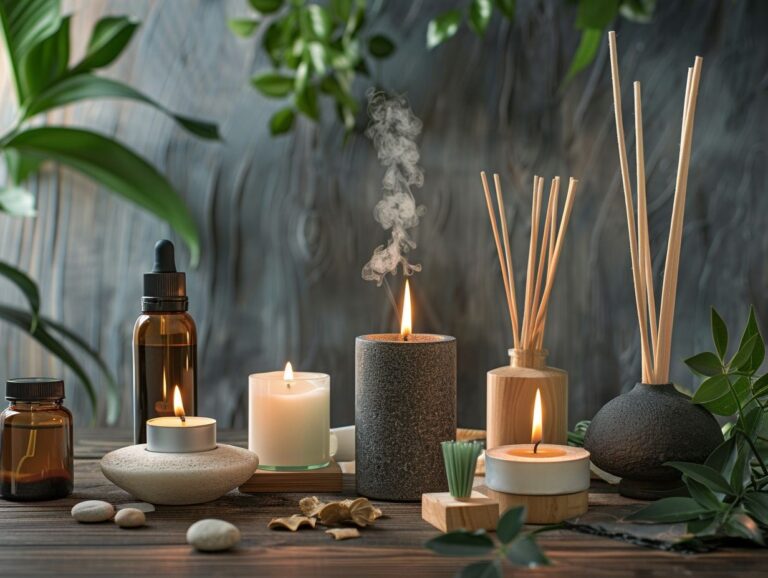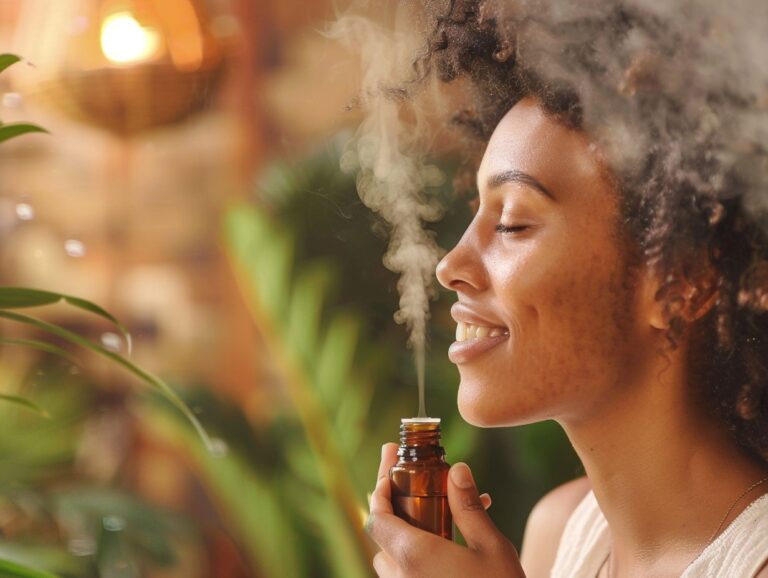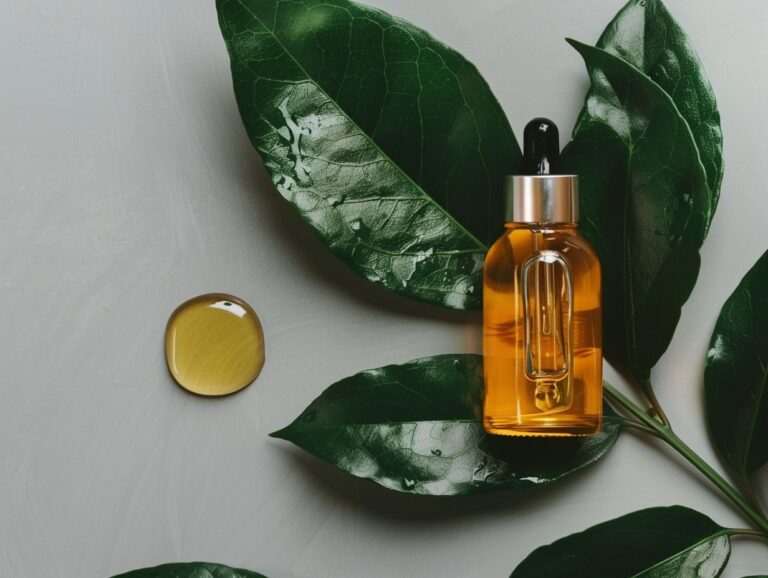Can Aromatherapy Be Used for
Weight Loss? Have you ever wondered about the benefits of aromatherapy and how it can improve your overall well-being? From reducing stress and anxiety to boosting mood and energy, aromatherapy offers a wide range of advantages.
In this article, we will explore what aromatherapy is, how it works, the different types of aromatherapy, safety precautions to keep in mind, and how you can incorporate aromatherapy into your daily routine.
So, sit back, relax, and let’s dive into the world of aromatherapy together.
Key Takeaways:
What Is Aromatherapy?
Aromatherapy is a holistic therapy that utilizes essential oils to promote health and well-being. It involves the use of aromatic plant compounds to improve a person’s physical, emotional, and spiritual health.
Originating from ancient civilizations like Egypt, China, and India, aromatherapy has a rich history rooted in the belief that natural remedies can bring balance and healing to the body. The purpose of this alternative healthcare practice is to harness the therapeutic benefits of plant essences, known as essential oils, which are extracted through various methods such as distillation or expression. These aromatic oils are then used in massages, baths, inhalation, and diffusers to address a wide range of physical and mental ailments. Aromatherapy is widely applied in healthcare settings as a complementary treatment to support conventional medicine by promoting relaxation, reducing stress, and enhancing overall well-being.
How Does Aromatherapy Work?
Aromatherapy works by stimulating the olfactory nerves in the nose, which then send signals to the brain’s emotional center. The scent molecules from essential oils trigger specific responses in the body and mind.
When inhaled, these aroma molecules travel through the nose and reach the olfactory bulb, a structure in the brain where smell is processed. This direct connection between scent and emotional center allows for the rapid influence on mood and feelings. The brain interprets these scent signals, which can then trigger memory recall, the release of neurotransmitters, and even impact heart rate and blood pressure.
What Are the Benefits of Aromatherapy?
Aromatherapy offers a range of benefits for both physical and emotional well-being. Its therapeutic applications include improving skin health, reducing stress, and supporting holistic healing treatments.
Many essential oils used in aromatherapy are known for their skin-enhancing properties, such as promoting hydration, soothing irritation, and minimizing signs of aging.
The calming scents from essential oils can help lower stress levels, improve mood, and create a sense of relaxation and well-being. Learn more about why aromatherapy is used for these benefits.
In holistic healing practices, healthcare providers often incorporate aromatherapy to complement other treatments, aiming to address the individual as a whole, including their physical, emotional, and spiritual needs.
Reduces Stress and Anxiety
Aromatherapy is known for its ability to reduce stress and anxiety by promoting relaxation and calming the emotions. Research studies have shown the positive impact of essential oils in alleviating symptoms of stress and anxiety.
Research has suggested that certain essential oils can have a significant effect on lowering cortisol levels, a hormone associated with stress. For instance, lavender oil is widely recognized for its calming properties, while citrus oils like bergamot and orange have been found to uplift mood and reduce anxiety. Methods of application include diffusing oils in the air, adding a few drops to a warm bath, or using them in massage oils. These techniques can help create a soothing environment and provide relief from daily tensions.
Improves Sleep Quality
Aromatherapy can improve sleep quality through the use of calming essential oils that promote relaxation and reduce insomnia symptoms. The soothing scents help create a tranquil environment conducive to restful sleep.
Among the top essential oils known for their soothing properties are lavender, chamomile, and cedarwood. Lavender is widely used for its ability to induce relaxation and reduce anxiety, making it ideal for bedtime routines. Chamomile has gentle sedative effects, promoting a sense of calmness and aiding in falling asleep faster. Cedarwood is known for its grounding properties, helping to quiet the mind and alleviate stress.
To incorporate aromatherapy into your bedtime routine, try using a diffuser to release the scents into the air, or mix a few drops of essential oil with a carrier oil for a relaxing massage. You can also add a few drops of your chosen essential oil to a warm bath or sprinkle a few drops on your pillow for a restful night’s sleep.
Alleviates Pain and Inflammation
Aromatherapy has shown promise in alleviating pain and reducing inflammation through the topical application of specific essential oils. The therapeutic properties of these oils can provide relief from various types of pain and discomfort.
One such essential oil known for its analgesic properties is Peppermint oil. Peppermint oil contains menthol, which has a cooling effect that can help numb pain. It is often used to soothe headaches and muscle aches.
Lavender oil is another popular choice due to its calming nature, which can help reduce stress-related pain. When used in conjunction with massage therapy or added to a warm bath, these essential oils can enhance the treatment of localized pain.
Boosts Mood and Energy

Aromatherapy is known to boost mood and energy levels by uplifting the spirits and promoting a sense of well-being.
The invigorating scents of certain essential oils can help improve mood and increase vitality. Lavender, known for its calming properties, can reduce stress and anxiety, leading to a more relaxed state of mind. Citrus oils like lemon and orange are refreshing and energizing, providing an instant mood lift. Discover where aromatherapy is used for more information.
To incorporate aromatherapy into your daily routine, try adding a few drops of your favorite essential oil to a diffuser or creating a relaxing bath by mixing oils with Epsom salts. This holistic approach to healing the body can have a profound impact on your overall well-being and energy levels.
What Are the Different Types of Aromatherapy?
There are several types of aromatherapy, including inhalation, topical application, aerial diffusion, and direct inhalation. Each method offers unique benefits and applications for using essential oils.
Inhalation involves breathing in the aromatic compounds of essential oils either directly or through techniques like steam inhalation or using a diffuser.
Topical application refers to the application of diluted essential oils on the skin, often in the form of massages or skincare products.
Aerial diffusion disperses essential oils into the air through devices like diffusers, creating a pleasant and calming atmosphere.
Direct inhalation involves smelling essential oils from a bottle or cloth without applying them to the skin, providing quick relief for respiratory issues or emotional support.
Inhalation
Inhalation is a common method in aromatherapy where scent molecules from essential oils are inhaled to promote therapeutic effects. This direct pathway to the brain can have rapid and effective results.
When essential oil vapors are inhaled, they can directly affect the limbic system in the brain, which controls emotions, memories, and behaviors. The aroma triggers receptors in the nose, sending signals to the brain and influencing physiological responses. Inhaling essential oils is not just about enjoying a pleasant scent; it can also help alleviate stress, improve mental clarity, boost energy levels, and even enhance mood.
Some essential oils that are commonly recommended for inhalation include:
- Lavender
- Peppermint
- Lemon
These oils are known for their calming, invigorating, and uplifting properties, making them ideal for promoting relaxation, clarity, and overall well-being through inhalation.
Topical Application
Topical application involves applying essential oils directly to the skin for absorption. The oils penetrate the skin barrier and enter the bloodstream, providing localized and systemic benefits.
When considering skin safety during topical application of essential oils, it’s crucial to dilute them properly to avoid irritation or sensitization. Patch testing on a small area of skin before widespread use can help identify any potential adverse reactions. Opting for high-quality oils sourced from reputable suppliers is paramount for ensuring effective absorption and minimizing the risk of adverse effects.
In the realm of medicinal use of essential oils, the choice of oils plays a pivotal role in achieving desired therapeutic outcomes. Essential oils with specific properties such as anti-inflammatory, antimicrobial, or wound-healing properties are commonly utilized for skin conditions or soothing muscle aches.
Aerial Diffusion
Aerial diffusion is a method of dispersing essential oil molecules into the air through diffusers or sprays. This technique was popularized by the French perfumer Ren -Maurice Gattefoss for its therapeutic benefits.
The process of aerial diffusion entails breaking down the volatile scent molecules of essential oils and releasing them into the surrounding atmosphere, where they can be inhaled or absorbed through the skin. These scent molecules interact with the olfactory system when inhaled, affecting the brain and emotions.
Common diffuser types include ultrasonic diffusers, nebulizing diffusers, and evaporative diffusers, each offering unique methods of dispersal. Ultrasonic diffusers use water and ultrasonic vibrations, while nebulizing diffusers atomize the oils without heat, preserving their therapeutic properties. Evaporative diffusers utilize a fan to disperse oils into the air.
Direct Inhalation
Direct inhalation involves smelling essential oils directly from the bottle or a cloth. This method stimulates the olfactory nerves and can have immediate effects on the body and mind.
By inhaling essential oils directly, individuals can experience quick relief from symptoms such as headaches, stress, or nausea. The aromatic compounds in the oils interact with the brain’s limbic system, which is responsible for emotions and memory, offering emotional support and relaxation. It is important to consult a healthcare provider before using direct inhalation, especially for those with respiratory conditions or sensitivities. Learn more about aromatherapy uses.
To practice safe direct inhalation, a few drops of essential oil can be added to a cloth or a cotton ball and held near the nose, allowing for subtle inhalation. Utilizing this method mindfully and responsibly can enhance well-being in various situations.
What Are the Safety Precautions for Aromatherapy?
When using aromatherapy, it is essential to follow safety precautions to prevent adverse reactions. Diluting essential oils properly, avoiding sun exposure, and consulting with a healthcare provider are crucial steps in ensuring safe usage.
Proper dilution of essential oils is key to avoiding skin irritation or other negative effects. The general guideline is to use a 2% dilution ratio, which means adding approximately 12 drops of essential oil to every 1 ounce of carrier oil.
Additionally, sun safety is often overlooked in aromatherapy. Certain essential oils, like citrus oils, can make the skin more sensitive to UV rays, leading to sunburn. Always check the safety guidelines for each oil before topical application.
It is always wise to seek professional guidance when using essential oils, especially if you are pregnant, nursing, or have underlying health conditions. Healthcare providers can offer tailored advice based on your individual needs and potential interactions with medications or medical treatments.
Dilute Essential Oils Properly

In terms of diluting essential oils, it is crucial to select appropriate carrier oils such as jojoba, coconut, or almond oil to mix them with. Carrier oils help to slow down the evaporation rate of the essential oils and reduce the intensity of their effects on the skin.
Dilution ratios vary depending on the type of essential oil and the purpose of use. A common guideline is to mix 2-3 drops of essential oil with 1 teaspoon of carrier oil for topical applications. For sensitive areas or those prone to irritation, a higher dilution may be recommended.
Patch testing is imperative before using any diluted essential oil on the body. Apply a small amount of the diluted mixture on a small patch of skin and wait for 24 hours to check for any signs of irritation or sensitivity. This simple step can help avoid unpleasant reactions and ensure a safe and enjoyable experience with essential oils.
Avoid Sun Exposure
Certain essential oils can make the skin more sensitive to sunlight, leading to sunburn or pigmentation issues. It is important to avoid sun exposure after applying photosensitive oils to the skin.
Common photosensitive oils include citrus oils like lemon, lime, bergamot, and grapefruit, as well as certain floral oils such as lavender and ylang-ylang. When these oils are applied topically, they can increase the skin’s sensitivity to UV rays, making it more susceptible to damage.
To protect your skin from potential UV damage, it is crucial to always wear sunscreen with a high SPF when using photosensitive oils. Consider applying these oils to areas of the body that are less likely to be exposed to direct sunlight.
It’s essential to be mindful of any symptoms of sunburn or pigmentation issues, such as redness, inflammation, or darkening of the skin, and seek proper treatment if needed. Consult a dermatologist if you experience any concerning skin reactions after using these oils.
Use Caution During Pregnancy
Pregnant women should exercise caution when using aromatherapy, as certain essential oils may have adverse effects on pregnancy. Consulting with a healthcare provider is recommended to ensure the safety of essential oil use during pregnancy.
Avoid essential oils such as sage, rosemary, and juniper during pregnancy as they are known to potentially induce contractions or negatively impact hormonal balances. Instead, opt for safer oils like lavender, chamomile, and citrus oils, which are generally considered safe for use during pregnancy.
It is crucial to remember that each individual’s response to aromatherapy treatments can vary, especially during pregnancy. This is why seeking guidance from a healthcare provider who is knowledgeable about essential oils and their effects is highly recommended. While some oils may be beneficial, others can pose risks, hence a professional’s advice will ensure a personalized and safe approach to using aromatherapy treatments during pregnancy.
Consult with a Professional
Before starting an aromatherapy regimen, it is advisable to consult with a professional or aromatherapist. These experts can provide personalized guidance on essential oil selection and usage for specific health concerns.
Seeking advice from a qualified professional in aromatherapy is crucial due to the potential benefits of expert guidance. Aromatherapists, often experienced holistic healers, possess in-depth knowledge of essential oils and their therapeutic properties, enabling them to tailor recommendations for individual needs.
By consulting with a skilled healthcare provider specializing in aromatherapy, individuals can tap into a wealth of expertise, ensuring safe and effective utilization of essential oils. These practitioners can assist in addressing various issues, such as managing stress levels, enhancing relaxation, and promoting overall well-being.
Can Aromatherapy Be Used for Weight Loss?
Aromatherapy may complement weight loss efforts as a supportive treatment, but it is not a standalone solution for shedding pounds. Certain essential oils can help manage cravings, boost metabolism, and enhance relaxation, all of which can indirectly support weight loss goals.
For appetite control, oils like peppermint and grapefruit are known to have appetite-suppressing properties. They can help curb cravings and prevent overeating, thus aiding in weight management. Oils such as lavender and chamomile are popular for their calming effects, which can reduce anxiety levels and promote better stress management. Incorporating these oils into a diffuser or massage oil can create a soothing environment that supports a balanced mind-body connection during weight loss journeys.
How Can Someone Incorporate Aromatherapy into Their Daily Routine?
Incorporating aromatherapy into a daily routine can enhance well-being and promote relaxation. From using essential oil diffusers to creating DIY products, there are various ways to experience the benefits of aromatherapy throughout the day.
Diffusers are effective in dispersing aromatic molecules into the air, influencing mood and creating a calming atmosphere. Whether it’s lavender for relaxation or eucalyptus for a refreshing boost, essential oils can be tailored to individual needs.
For those keen on hands-on experiences, making your DIY products like scented candles or room sprays can be a fun and rewarding endeavor. To further amplify the soothing ambiance, consider incorporating soothing music and soft lighting into your aromatherapy rituals. Seeking advice from a healthcare provider before starting any aromatherapy regimen is advisable to ensure compatibility with any existing health conditions.
Use Essential Oils in a Diffuser
One way to incorporate aromatherapy into daily life is by using essential oil diffusers. These devices disperse aromatic oils into the air, creating a calming ambiance that promotes relaxation and well-being.
Diffusers not only enhance the atmosphere but also have numerous health benefits. When diffused, oils like lavender, chamomile, and bergamot can effectively reduce stress levels and uplift one’s mood. The gentle fragrance can help in easing tensions, calming the mind, and supporting emotional well-being. It is essential to choose a diffuser that suits your preferences – whether it’s an ultrasonic, nebulizing, or heat diffuser – to ensure optimal diffusion and maximum benefit from the oils you use.
Add Essential Oils to Bath or Shower

Not only does aromatherapy in the bath provide a luxurious and relaxing experience, but it also offers a range of health benefits. For example, lavender oil can promote relaxation and sleep, eucalyptus oil can help clear sinuses and improve respiratory health, and chamomile oil can soothe skin irritations.
When using essential oils, it’s essential to dilute them properly to prevent skin irritation. Mixing a few drops of your preferred oil with a carrier oil like coconut or jojoba can help disperse the oil evenly in the water.
Create DIY Aromatherapy Products
Get creative with aromatherapy by making your DIY products like massage oils, room sprays, or scented candles. Customizing your aromatherapy blends allows you to tailor the scents to your preferences and needs.
Experimenting with the art of blending essential oils can lead to remarkable outcomes for your well-being. Essential oils extracted from plants possess various therapeutic properties, offering benefits for both the mind and body. Mixing oils like lavender, peppermint, and eucalyptus can create invigorating massage oils to soothe tired muscles or refreshing room sprays for a calming ambiance in your home.
Creating your own aromatherapy products not only gives you control over the ingredients you expose your body to, but also allows you to explore the endless possibilities of scents and their healing properties. Whether you need a mood-booster, stress-reliever, or sleep aid, there’s a DIY aromatherapy blend waiting for you to unleash its potential.
Use Aromatherapy during Meditation or Yoga
Incorporating aromatherapy into meditation or yoga practices can enhance the mind-body connection and deepen relaxation. The synergistic effects of essential oils and mindfulness techniques can elevate the spiritual experience during these practices.
Essential oils like lavender and frankincense are particularly beneficial for promoting focus and relaxation, making them ideal choices for your meditation or yoga sessions. Lavender is known for its calming properties, while frankincense can help center the mind and enhance overall tranquility. To incorporate these scents effectively, consider diffusing them in your practice space or adding a drop to your wrists before starting your session. Consultation with a qualified healthcare provider can offer valuable insights on integrative medicine practices that include aromatherapy uses
Frequently Asked Questions
Can Aromatherapy Be Used for Stress Relief?
Yes, aromatherapy is commonly used for stress relief. Essential oils such as lavender, chamomile, and bergamot have calming properties that can help reduce feelings of stress and anxiety.
Can Aromatherapy Be Used for Pain Management?
Aromatherapy can be used for pain management. Certain essential oils like peppermint, eucalyptus, and rosemary have analgesic properties that can help alleviate pain and discomfort.
Can Aromatherapy Be Used for Respiratory Issues?
Yes, aromatherapy can be used for respiratory issues. Essential oils like eucalyptus, tea tree, and peppermint have expectorant and decongestant properties that can help clear the respiratory tract and improve breathing.
Can Aromatherapy Be Used for Skin Conditions?
Aromatherapy can be used for various skin conditions. Essential oils like tea tree, lavender, and chamomile have anti-inflammatory and antimicrobial properties that can help soothe and heal skin issues like acne, eczema, and psoriasis.
Can Aromatherapy Be Used for Insomnia?
Yes, aromatherapy can be used for insomnia. Essential oils like lavender, roman chamomile, and ylang-ylang have sedative properties that can help promote relaxation and improve sleep quality.
Can Aromatherapy Be Used for Headaches?
Aromatherapy can be used for headaches. Essential oils like peppermint, lavender, and eucalyptus have analgesic and anti-inflammatory properties that can help relieve headache pain and tension.








2 Comments